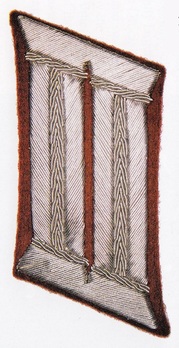German Municipal Police Officer's Collar Tabs
CATEGORY: Version
SKU: 52.GOR.03.02.02.02.002.000
Estimated market value:

Estimated market value:
During the Third Reich, an effort was made to unite all of Germany’s disparate provincial police forces and agencies into a single cohesive national unit. To attain this goal, Reichsführer-SS Heinrich Himmler was named Chief of the German Police in the Ministry of the Interior in June 1936. That same month, Himmler implemented new standardized uniforms, headgear, and insignia. The uniforms worn prior to Himmler’s appointment were often navy blue, particularly in what had been Prussia. The new uniforms were green, in a shade that was then dubbed “Police green”.
The German Police were divided into two main units, the Ordnungspolizei (Orps or Regular Police) and the Sicherheitspolizei (Secret Police); the Ordnungspolizei were unofficially called the green police (Grüne Polizei) as a result of their uniform colour. The Sicherheitspolizei were made up of two main organizations, the Gestapo and the Kriminalpolizei (Criminal Investigation Police). At the beginning of the Second World War, the Sicherheitspolizei were brought under the auspices of the Reich Main Security Office.
The Ordnungspolizei was also divided into smaller branches of service, and each branch was associated with a branch of service/troop colour (Truppenfarbe). The troop colours include:
Schutzpolizei des Reichs (National Protection Police): Green
Schutzpolizei der Gemeinden (Municipal Police) pre-1942: Red
Schutzpolizei der Gemeinden (Municipal Police) post-1942: Green
Gendarmerie (Gendarmes/Rural Police): Orange
Verwaltungspolizei (Administrative Personnel): Light grey
(Administrative Police members included ranks equivalent to Generalmajor down to and including Revieroberwachtmeister)
Feuerschutzpolizei (Fire Protection Police): Carmine
Wasserschutzpolizei (Water Protection Police): Yellow (members of this sub-organisation did not wear collar tabs)
Motorisierte Polizei (Motorised Police): White
Verkehrspolizei (Traffic Police): Bright red
Medical Police members: Cornflower blue (until 1941)
Veterinary Police members: Black (until 1941)
The German Police collar tabs were worn by police personnel as rank group indicators. The specific rank of the wearer was identified by the shoulder boards worn along with the collar tabs. The Police Generals collar tabs are the only exception to this rule: a General’s specific rank was identifiable by the number of pips on the collar tabs.
Pre-Third Reich Police collar tabs were worn until 1936 with the release of new uniforms and insignia. The collar tabs are mirror images of each other. They take the form of a parallelogram, with the General and Officer collar tabs being slightly larger than those for Non-Commissioned Officers (NCOs) and Enlisted Men (EMs).
There are two patterns of collar tabs for Generals.
The 1st pattern collar tabs are the same for all General ranks. It was first introduced in 1932 and is similar to that used by Army Generals, but with a green backing. It features a gold-coloured Arabesque style embroidery known as a “Larisch” embroidery. Administrative Generals wore these collar tabs with a light grey backing.
The 2nd pattern collar tabs were introduced in February of 1942. They were in the design of SS collar tabs, featuring three oak leaves with two acorns in gold-coloured embroidery on a green backing with gold-coloured (gilt) bullion cord piping.
Generals with the rank of Generaloberst wore an additional three gilt rank pips (either embroidered or made of metal), those in the rank of General wore two pips, those in the rank of Generalleutnant wore one pip, and those in the rank of Generalmajor wore no pips.
For Officers, NCOs, and EMs the cloth underlay’s colour is associated with the wearer’s branch of service/troop colour (Truppenfarbe).
Collar tabs for Officers feature two elaborately embroidered Litzen (bars) made from silver-coloured bullion wire and no border piping.
Officers in the rank of Hauptmann and above assigned to the Police Head Office (Hauptamt Ordnungspolizei) wore Litzen that were even more elaborate, in the form of those worn by Army general staff. The Litzen style is known as “Kolbenstickerei” (piston embroidery).
Collar Tabs for NCOs feature two basic Litzen composed of silver/aluminum flat wire and a border of silver-coloured (aluminum) bullion cord piping.
Collar tabs for EMs feature two basic Litzen made of silver/aluminum flat wire and no border piping.

Comments
Sign in to comment and reply.


Scroll Top